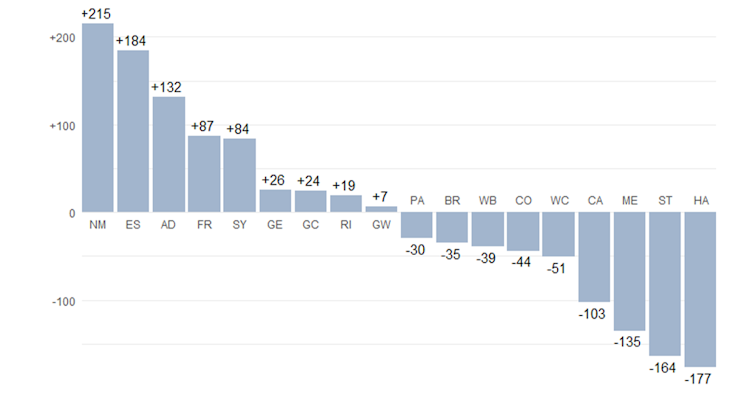The Stats And Facts: Just How Unfair Is AFL Free Agency?
Last updated: Nov 11, 2020, 1:55AM | Published: Nov 9, 2020, 12:10AM
Free Agency has been apart of the AFL landscape for nearly a decade now and a flurry of activity last Friday has made it once again one of the hot topics of this year’s player movement period.
Every footy fan and their dog has an opinion on free agency – we all agree it’s not working but few if any agree on the best way to fix it.
But before we get to fixing, we need to know the facts: so let’s dive into the numbers and see if we can answer a few of the most common questions about free agency.
RELATED: AFL Trade Period Primer: A List Analysis Of Every Club

To start with some basics – since free agency arrived in 2012, 93 players have used it to move from one AFL club to another.
MORE: 2020 AFL Free Agency & Trade Period Tracker
23 of those were restricted free agents, 26 unrestricted, and the rest delisted. We won’t talk about the delisted players today - just those whose clubs might’ve liked to keep them.
In the chart above you can see those 49 restricted and unrestricted free agents grouped by the band of compensation pick that was awarded for their departure.
My biggest takeaway from this is that big-name free agency moves haven’t actually been that common. Before 2020 you could’ve counted the band-1 free agents on one hand.
This year looks to be one of the busiest yet – it’s only the second time we’ve had two band-1 compensation picks in a single season, and the equal-most compensation picks of any kind in a single year.
Whether that’s the beginning of a trend or simply an outlier is something we won’t know for sure until we see how the next couple of years play out.

WHICH CLUBS HAVE BENEFITTED THE MOST?
Adding up which clubs have lost or gained the most free agents over the years doesn’t say a whole lot, simply because one free agent is not equal to another. The Hawks lost a lot more when they said goodbye to Lance Franklin than when they did the same for Clinton Young.
Instead, the above chart uses the number of games played by each free agent after moving clubs to add up every club’s net games gained or lost by signing or losing free agents.
North Melbourne – who’ve signed the likes of Shaun Higgins, Jarrad Waiteand Nick Dal Santo via free agency, while losing only Daniel Wells – are perhaps a surprising team to see come out on top.
They’ve made gains in free agency not by landing any one big fish, but through some canny pick ups of shall we say medium-sized fish.
Some other teams in that top five – Essendon, Adelaide and Sydney – are more in the ‘big fish’ category, reaping the benefits of signing Brendon Goddard, Eddie Betts and Lance Franklinrespectively.
At the other end of the scale is Hawthorn, who’ve lost no less than seven players to free agency over the journey – most recently Isaac Smith.
The number of games gained and lost can give us a good indication of which clubs have benefitted most, but it says nothing about the quality of those games.
Instead we can look at the net coaches votes gained or lost by signing or losing free agents in the chart above.
Overall it correlates pretty well to the previous chart – North Melbourne are again at the top, and Hawthorn again at the bottom.
But Sydney have moved up from fifth to second showing just what a significant signing Lance Franklin was, while a team like Gold Coast has gone from a positive differential to the negatives.
The biggest takeaway from these numbers is that on-field success doesn’t necessarily mean free agency domination – both ends of the scale feature some clubs who’ve been successful and some who’ve been mediocre during the free agency era.
RELATED: Does Josh Dunkley make Essendon legitimate contenders?
DO FREE AGENTS REALLY GO TO PREMIERSHIP CONTENDERS?
Often the biggest complaint levelled at free agency is that when players move, they move up the ladder to premiership contenders, hurting the AFL’s efforts at equalisation.
But, as we saw in the previous chart, some of the AFL’s successful sides have been the worst hit, while others who are quite middling have at times done well.
Answering this question then requires some further investigation. For that, I put together the win count of each free agent’s clubs from-and-to in the year they moved.
James Frawley in 2014 for example moved from a Melbourne side that had won 4 games that year to a Hawthorn side who had won 20 – a perfect example for the ‘equalisation’ complaint.
Brandon Ellis in 2019 on the other hand did almost the exact opposite, moving from 19-win Richmond to 3-win Gold Coast.
On average over the last nine years, clubs losing free agents have had -0.6 wins that year compared to the team they lose them to – by no means a big difference.
But if we break those numbers up by bands we see larger trends. Band-1 free agents on average have moved to clubs with +4.3 wins that year compared to their former home.
On the other hand, free agents in band-4 or lower typically move from better teams to worse ones – declining -1.2 wins on average.
Overall, the numbers suggest that when the best free agents move clubs, they do go to better-performing teams. In fact, Carlton this year became the first team to sign a band-1 or 2 free agent without winning at least 11games in that season.
But it’s important to remember that players of all levels of quality use free agency – many going to less competitive teams in search of greater opportunity.
RELATED: Charting The AFL Premiership Clock: How Far Is Your Club From Its Next Flag?
IS FREE AGENCY COMPENSATION FAIR?
No part of free agency boils a footy fan’s blood more than compensation picks, and in 2020 they’ve been as controversial as ever.
Is the compensation system fair? If we’re asking whether it’s fair for the competition as a whole, it seems pretty straightforward to say no. As was well put by HPNfooty, “free agency compo is an 18-club trade with 16 losers.”
But are the compensation picks that get dealt out a fair replacement for talent lost? That’s a different question, and one we can look into.
Everyone can name compensation picks that have been wildly above or below what the consensus would consider fair value – pick 19 for Lance Franklin comes to mind!
But any system will have some anomalous results. How are the compensation picks doing on average?
Overall, there have been 24 free agents who generated a compensation pick which was then directly used to draft a player (rather than being used to partially match a father-son or academy bid).
If we compare the games played and coaches votes for each free agent and their draftee counterpart, on average the free agents are winning by an extra +3.9 games and +23.4 votes to date.
That’s not that much – especially when you consider the caveat that free agency is still very new, and most of the players we’re talking about (particularly the compensation draftees) are still active in the competition.
It seems natural that when getting draft compensation for a mature player the mature player is probably going to have an impact more quickly, and the compensation take longer to produce value.
A great example would be Tom Rockliff. Since joining Port Adelaide he’s played 52 games for 51 coaches votes – head and shoulders above the player taken with his compensation pick, Brandon Starcevich, on 23 and 5.
But Rockliff is 30 and Starcevich 21, the latter only just becoming an AFL regular this year. In ten years’ time there’s a good chance he’ll be well ahead.
I suspect in the longterm, compensation pick draftees will outperform free agents on average – though there’ll no doubt always be some significant outliers for and against.
What about free agents who didn’t attract compensation? Were they fair decisions? Well, look for yourself.

So far the only non-compensated free agent to really make a mark is Jarrad Waite. No one else in this group has more than a single-digit tally of coaches votes at their new club, he has 70+.
Many Carlton fans felt aggrieved at the lack of compensation when he left the club – and the numbers he produced thereafter suggest that maybe they had a point.
RELATED: Why Ben Brown To Melbourne Is A Devilishly Good Match
CLOSING THOUGHTS
I agree with most criticisms of free agency, but it is worth acknowledging that a lot of the arguments around it possess plenty of hyperbole.
Do the best players mostly go to premiership contending clubs? Yes, but very few players of that calibre move through free agency anyway – less than one a year, so far.
Are compensation picks too generous to clubs losing free agents? Probably, in the long run – but even then perhaps not by that much.
After nearly a decade of experience with it, we should definitely be taking a close look at the outcomes so far and seeing if we can’t tweak free agency to make it more equitable.
But is it the “disaster” some have labelled it as? I wouldn’t go that far just yet.
Did you enjoy this article? Join our free mailing list to get the best content delivered straight to your inbox, or join the conversation by leaving a comment below or on the Stats Insider Twitter or Facebook page.



